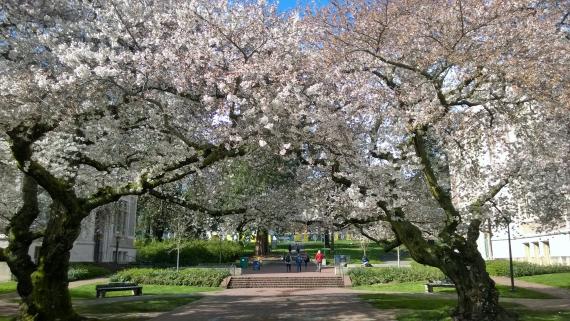The Origins of German and its Closest Relatives
The legend goes that only one vote prevented German from becoming the official language of the colonies that predated the USA. Despite being opponents in this case, German and English share common features and a linguistic genealogy. This class offers an introduction to the origins of these two languages and their closest relatives with a special focus on the sociolinguistic context. Over the course of the quarter, students will familiarize themselves with Old High German, Old English, Gothic, Old Norse, Old Saxon, and Old Low Franconian regarding their linguistic features, the people who spoke it, and the literature they produced. Students will acquire an understanding of the origins of these Germanic languages starting with Proto-Indo-European. In addition, over the course of the quarter, students will gain familiarity with patterns of language and language changes, and will be able to reconstruct the relationship of some modern languages, such as English and German. As part of their projects, students will bring diverse historic voices into dialogue within the framework of digital media and create an online exhibition about objects of significance for the history of these Germanic languages.
There are no prerequisites for this course.
Catalog Description:
Introduction to basic grammatical concepts, terminology, and linguistics with emphasis on German-English relationship. Overview of phonology, morphology, syntax, and history of Germanic languages and people, both ancient and modern. Languages covered include Old, Middle, and New High German; English, Frisian, Dutch, Old Saxon, and Gothic. Taught in English.
Instructor: Annegret Oehme (oehme@uw.edu)
GERMAN 220A Offered: jointly with LING 220.
Cultures of Extinction
With the future of the Endangered Species Act at stake, this course takes a multi-disciplinary approach to understanding one of the more wicked problems of the 21st century: The Sixth Extinction. Rather than approaching this event as a discrete biological phenomenon, this course looks at how current threats to bio-diversity are implicated in, and connected to, threats to cultural diversity, in particular language loss. We will seek to understand how discourses of extinction, beginning from its “discovery” in the 18th century, are related to fraught histories of colonialism and imperialism, whose ecological and cultural effects extend into the present and threaten to shape the future.
While the course seeks to grasp the scale of the Sixth Extinction, it will also critically reflect upon, and propose alternatives to, the dominant apocalyptic narratives in which extinction is framed in the popular imagination. Course readings and critical texts drawn from across the humanities and social sciences will explore and critique various framings of “the end” in literature, art, music, and film.
Instructor: Jason Groves (jagroves@uw.edu )
GERMAN 298A/ ENVIR 495A/ ENGL 265A/ LIT 298A
Vienna 1900: Crisis and Renewal
This course is an interdisciplinary exploration of the literature and the visual culture of fin-de-siècle Vienna and the Austro-Hungarian Empire, and the aftermath of its disintegration into World War I. With an emphasis on the relationship between different disciplines (literature, art, critical theory, history and psychology) the course will be organized around major themes from the period, such as sexuality, gender, decay, and the crisis of identity and language. The analysis of works such as Egon Schiele's self-portraits reveals mankind's crisis of identity when confronted by an era characterized by the absence of any ordering principles. Arthur Schnitzler's play Reigen and his novella Night Games unmask a battle of the sexes and the changing dynamic between men and women. Gustav Klimt's Secessionist paintings express a fresh hope for a renewal in art and society and his portrayal of the feminine form undercut previous views regarding gender and sexuality. Hugo von Hofmannsthal's Chandos Brief lays bare the notion that the inherited language of past traditions is no longer capable of expressing modern man's experience. Wes Anderson's modern film The Grand Budapest Hotel seeks to capture the decay of the Empire as it holds up a mirror which brilliantly reflects 'the world of yesterday' that Stefan Zweig so faithfully describes as he looks back to the Vienna of his youth. Finally, with the primary texts read against a variety of social, historical and theoretical texts pertinent to the topics and the era, such as Sigmund Freud's Civilization and Its Discontents, Carl Schorske's Fin-de-Siècle Vienna Politics and Culture and Hermann Broch's Hofmannsthal and His Time, the course will inquire into the relationship between the political and social change of Vienna and it's literary and artistic representation.
Through written, analytical responses as well as creative individual and group projects, students will have the opportunity to delve into other cultural aspects of the city, both from the turn of the century and contemporary Vienna. For example, students will collaborate on contributions to a feuilleton journal for the course modeled on Karl Kraus' Die Fackel, which will feature their creative interpretations of the cultural, literary, social and artistic trends of the turn of the century.
Instructor: Kye Terrasi (kterrasi@uw.edu )
GERMAN 351A/ LIT 298B/ C LIT 320A
